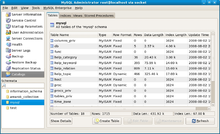MySQL Workbench
MySQL Workbench es una herramienta visual de diseño de bases de datos que integra desarrollo de software, Administración de bases de datos, diseño de bases de datos, creación y mantenimiento para el sistema de base de datos MySQL. Es el sucesor de DBDesigner 4 de fabFORCE.net, y reemplaza el anterior conjunto de software, MySQL GUI Tools Bundle.
Historia
fabFORCE.net DBDesigner4

DBDesigner4 es una herramienta de diseño de bases de datos open source y ejecutador de consultas lanzado bajo la GPL.[1] Fue escrito en 2002/2003 por el programador austrialiano Michael G. Zinner para su plataforma fabFORCE.net usando Delphi 7 / Kylix 3.[2][3]
MySQL GUI Tools Bundle

Las MySQL GUI Tools Bundle es una suite open source multiplataforma de aplicaciones de escritorio para la administración de servidore de bases de datos MySQL, y para construir y manipular los datos en una base de datos MySQL.Fue desarrollado por MySQL AB y después por Sun Microsystems y lanzado bajo la GPL. El desarrollo de las GUI Tools bundle fue detenido, y ahora solo preservado bajo los Archives de descarga del sitio de MySQL[4]
Las GUI Tools bundle han sido superadas por el MySQL Workbench, y han llegado al final de su vida con la beta de MySQL Workbench 5.2., Sin embargo, el soporte del equipo de MySQL continua proveyendo asistencia para las bundle hasta Junio 30, 2010.[5] Futuros lanzamientos de MySQL Workbench añadirán un plugin de migración, añadiendo características equivalentes al componente MySQL Migration Toolkit de las MySQL GUI Tools bundle.
Releases
La primera versión previa de MySQL Workbench fue liberada en septiembre de 2005,[6] y no fue incluida en la MySQL GUI Tools Bundle. El desarrollo fue comenzado nuevamente en 2007 y MySQL Workbench estuvo preparado para volverse el producto insignia de MySQL GUI.[7]
El versionado comenzó con la 5.0, para remarcar el hecho que MySQL Workbench fue desarrollado como el sucesor de DBDesigner4.[8]
MySQL Workbench 5.0 y 5.1
MySQL Workbench 5.0 y 5.1 son herramientas visuales especializadas para bases de datos MySQL. Mientras MySQL Workbench 5.0 era un producto exclusivo de MS Windows el soporte cross-platform fue agregado a MySQL Workbench 5.1 y posterior.[9][10]
MySQL Workbench 5.2
A partir de MySQL Workbench 5.2, cuando la aplicación se ha desarrollado una base de datos general de aplicación GUI. Aparte de modelado de base de datos física que cuenta con un editor de SQL y un servidor de base de datos Interfaz de administración, en sustitución de la antigua MySQL GUI Bundle herramientas. La nueva aplicación sin embargo todavía no es compatible con la migración de datos, que era una parte del conjunto de herramienta antigua.
MySQL Workbench 6.2
Características
Las características destacadas de MySQL Workbench 5.2 son:
- General
- Editor de SQL
- Schema object browsing
- SQL syntax highlighter and statement parser
- Multiple-, editable result sets
- SQL snippets collections
- SSH connection tunneling
- Soporte Unicode
- Modelado de datos
- Diagrama entidad relación
- Drag'n'Drop visual modeling
- Reverse engineering from SQL Scripts and live database
- Forward engineering to SQL Scripts and live database
- Sincronización de esquema
- Printing of models
- Import from fabFORCE.net DBDesigner4
- Database administration
- Start and stop of database instances
- Instance configuration
- Database account management
- Instance variables browsing
- Log file browsing
- Data dump export/import
Licenciamiento y Ediciones
MySQL Workbench es uno de los primeros productos de la familia MySQL que ofrece dos ediciones diferentes - una open source y una edición comercial.[11] The "Community Edition" is a full featured product that is not crippled in any way. Being the foundation for all other editions it will benefit from all future development efforts. The commercial "Standard Edition" extends the Community Edition with a series of modules and plugins.[12]
As this business decision was announced soon after the takeover of MySQL by Sun Microsystems, this has caused speculation in the press about the future licensing of the MySQL database.[13][14]
Community reception and reviews
Since its introduction MySQL Workbench has become popular within the MySQL community. Since 2010 it is now the second most downloaded product from the MySQL website with more than 250,000 downloads a month.[15] Before that it was voted Database Tool of the Year 2009 on Developer.com.[16]
MySQL Workbench has been reviewed by the open source community and print magazines.[17][18][19][20]
Véase también
Referencias
- ↑ DBDesigner4 Webpage, fabFORCE.net. Retrieved 2010-03-26.
- ↑ fabFORCE.net About Page, fabFORCE.net. Retrieved 2010-03-26.
- ↑ DBDesigner4 Source Code Download, fabFORCE.net. Retrieved 2010-03-26.
- ↑ MySQL GUI Tools Bundle: Archived Downloads, MySQL.com, Retrieved 2010-03-26.
- ↑ MySQL Product Support EOL Announcements, MySQL.com, Retrieved 2010-03-26.
- ↑ MySQL GUI Bundle announcement (without MySQL Workbench), MySQL.com Forum Archive, Retrieved 2010-03-26.
- ↑ Workbench Schedule Announcement, MySQL.com Forum Archive, Retrieved 2010-03-26.
- ↑ MySQL Workbench FAQ - General, MySQL Workbench Blog, Retrieved 2010-03-26.
- ↑ Michael G. Zinner, "Why Release on Windows First", MySQL Workbench Blog, recuperado en 2010-03-26.
- ↑ MySQL Workbench Releases, MySQL Workbench Blog, Retrieved 2010-03-26.
- ↑ MySQL Workbench Editions, MySQL Workbench Blog. Retrieved 2010-03-26.
- ↑ Michael G. Zinner, "Beta testers wanted!", MySQL Mailing List Archives, 2007-11-19. Retrieved 2010-03-26.
- ↑ Sun Introduces MySQL Workbench, O'Reilly Conference News, Retrieved 2010-03-26.
- ↑ Sean Michael Kerner, "MySQL Not Going Closed Source?", internetnews.com. Retrieved 2010-03-26.
- ↑ MySQL Workbench Contribute Page, MySQL Workbench Blog. Retrieved 2010-03-26.
- ↑ Winners - Product of the Year 2009, Developer.com, 2009-01-14. Retrieved 2010-03-26.
- ↑ Jack Wallen, "Get to Know MySQL Workbench", Linux.com, 2010-03-16. Retrieved 2010-03-26.
- ↑ Konstantin Mirin, "MySQL Workbench – The Database Modeling Tool for MySQL", programmersnotes.info, 2009-03-01. Retrieved 2010-03-26.
- ↑ Cal Evans, "MySQL Workbench – A Superficial Review", blog.calevans.com, 2009-07-05. Retrieved 2010-03-26.
- ↑ MySQL Workbench 5.1: Too many tables and too many complex relationships? Visualize your MySQL database with MySQL Workbench., Linux Magazine, 2001-03-19. Retrieved 2010-03-26.
Enlaces externos
- MySQL Workbench Product home page, MySQL.com. Retrieved 2010-03-26.
- MySQL Workbench Developer Central webpage, wb.MySQL.com. Retrieved 2010-03-26.
